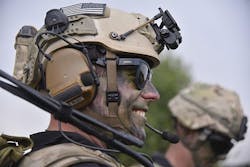Special Forces sets May technology demonstration for artificial intelligence (AI) and cognitive modeling
TAMPA, Fla. – Weapons experts at U.S. Special Operations Command (SOCOM) at MacDill Air Force Base, Fla., are inviting companies to demonstrate new enabling technologies in artificial intelligence (AI), machine learning, and robotic process control; hyper-enabled operator; and next-generation imagery, surveillance, and reconnaissance (ISR).
SOCOM will sponsor a technology demonstration called the Disrupter Event from 20 to 22 May 2019 at Tampa Convention Center, 333 South Franklin St., Tampa, Fla. 33602. The event happens at the same time as the Special Operations Forces Industry Conference (SOFIC) at the Tampa Convention Center.
During the event, participants private one-on-one session with evaluation panel to pitch, demonstrate, and discuss their solutions. SOCOM officials want to enter into agreements with industry partners with promising solutions. If the SOCOM technology demonstration evaluation panel favorably evaluates a solution brief at the demonstrations, negotiations may begin immediately.
This event is considered competitive in the same manner as a broad agency announcement or commercial solutions opening, and solutions will be evaluated independently for technical merit.
Related: Adaptive and bistatic electronic warfare
Applications for artificial intelligence, machine learning, and robotic process automation may for predictive maintenance; warfighter mental and physical health; cyber protection and resilience; logistics; contract management; and partnered force operations.
Technologies may involve cognitive problem-solving software; power-efficient chips and solid-state circuits; AI-enhanced smart phones and portable devices; simulations and cognitive modeling assessment tools; autonomous or cognitive capabilities for drones, vehicles and robotics; and tools and that reduce cognitive workload.
Capabilities of interest for artificial intelligence, machine learning, and robotic process automation include perception; speech recognition; document analysis; signals analysis; natural language processing; recommendation engines; and autonomous action, navigation, and movement.
Technologies of interest for hyper-enabled operator include edge computing and analytics; layered and automated tactical communications and navigation; tailorable human machine interfaces; adaptable flexible sensors; biometric and forensic analysis tools; social network mapping and sentiment measurement tools; interoperability and integration standards and models; heuristic or probabilistic techniques to speed decision making; telemetry and Internet of battlefield things; intuitive mobile applications; and technologies that increase stand-off identification and characterization.
Related: The new world of counter-drone technology
Technologies of interest for next-generation ISR include imagery, surveillance, and reconnaissance tools; standoff biometrics; micro and nano technology; unattended sensors; data aggregation; spectrum detection and location; meshed and layered networking; multi-domain sensor fusion; cognitive man-machine interfaces; social network mapping; and predictive sentiment analysis tools.
Companies interested should submit white papers no later than 3 April 2019 online at https://sofwerx.wufoo.com/forms/wo6tj441xqosqn. For questions or concerns contact John Kenney by email at [email protected], or by phone at 813-826-5671.
More information is online at www.sofwerx.org/disrupter, www.sofwerx.org/wp-content/uploads/Disrupter-TFAs-5-Mar-2109-002.pdf, or https://www.fbo.gov/spg/ODA/USSOCOM/SOAL-KB/USSOCOM2019DISRUPTER/listing.html.
Ready to make a purchase? Search the Military & Aerospace Electronics Buyer's Guide for companies, new products, press releases, and videos

